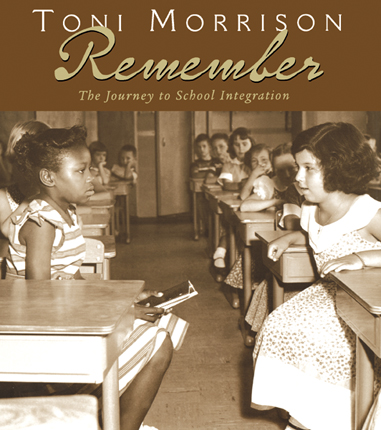Full Text Reviews: School Library Journal - 06/01/2004 Gr 3-8-This unusual blend of archival photographs, historical background, and fictional narrative brings to life the experiences and emotions of the African-American students who made the tumultuous journey to school integration. Dramatic, mostly full-page, black-and-white photographs make up the bulk of the book. An introduction sets the scene, and factual pages, consisting of several sentences, are scattered throughout. They explain the significance of the events, the trauma of racial conflict, the courage and determination of African Americans and their supporters, and the importance of remembering and understanding. With poignant simplicity and insight, Morrison imagines the thoughts and feelings of some of the people in the pictures. The wrenching, inspiring autobiographical school integration memoirs of first-grader Ruby Bridges (Through My Eyes [Scholastic, 1999]) and Little Rock Nine high school junior Melba Pettillo Beals (Warriors Don't Cry [Washington Square, 1995]) offer greater immediacy and convey a powerful message for future generations about the need for understanding, self-awareness, and self-respect. However, Morrison's reflective interpretation presents a gentler guide for younger readers. Appended are a chronology of "Key Events in Civil Rights and School Integration History"; "Photo Notes" that describe the actual date, location, and content of each picture; and a dedication that recalls the four young girls killed in the bombing of their Birmingham, AL, church in 1963. The provocative, candid images and conversational text should spark questions and discussion, a respect for past sacrifices, and inspiration for facing future challenges.-Gerry Larson, Durham School of the Arts, NC Copyright 2004 Reed Business Information. - Copyright 2004 Publishers Weekly, Library Journal and/or School Library Journal used with permission. Bulletin for the Center... - 07/01/2004 In this album of crisply reproduced sepia-toned photographs, Morrison revisits the days of substandard segregated schools for black children, the volatile confrontations and quiet successes of school integration, and subsequent civil rights activities that extended the demand for equal access beyond schools to all public businesses and facilities. Morrison provides captions intended to reconstruct "the thoughts and feelings of some of the people in the photographs chosen to help tell this story." Many captions play on the obvious—a host of children outside a Texas school that refused their admission appear beside "No, no, they said. You can't come in here." The best are truly provocative, though, as when Morrison interjects a caption between contrasting pictures and explodes its meaning with possibilities. An integrated bunch of youngsters dashes, smiling, out the school door, and a crew of white teens attempts to tip a black driver's car, while the caption intones, "Great! Now we can have some fun!" Black and white girls stare at each other across the aisle, and it is possible that either can be pondering, "I think she likes me, but how can I tell?" At this anniversary year of Brown v. Board, many authors weigh in with commemorative and instructive works, but Morrison's choice of photographic history invites viewers into an experience more visceral than anecdotal memories. Thumbnail reproductions of each featured photo, along with its specific historical setting, are appended for children who want more information, but this evocative gallery roars louder than words. - Copyright 2004 The Board of Trustees of the University of Illinois. Booklist - 04/15/2004 The photos are electrifying. Beautifully reproduced in sepia prints, the archival images humanize the politics of the civil rights movement. The leaders are shown, but the focus is on ordinary young people and the role they played in school integration. In her eloquent introduction, Morrison talks about what the pictures show: the reality of separate but equal, the 1954 Brown vs. Board of Education decision, the nationwide movement to eliminate racist laws. On the page opposite each photo, however, she imagines the thoughts and feelings of kids in the photos, and the intrusive fictionalized comments get in the way of the visual images (I think she likes me, but . . .What will I do if she hates me?). The fiction is not about the angry white mobs; there's no verbal racist confrontation. But there's hatred in the pictures, and children will constantly turn back to the photo notes at the end to find out more. Every library will want this not for the condescending made-up stuff but for the stirring history. - Copyright 2004 Booklist. Loading...
|



